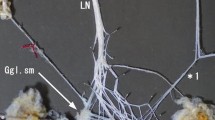Summary
Profiles of nerve plexuses in the arteriovenous anastomoses of the dog tongue were investigated by both transmission and scanning electron microscopy. Three-dimensional morphology of the vascular nerves was examined after removal of the connective tissue components by the HCl-hydrolysis method. Tight bending and a rich nerve supply were the most characteristic features of the anastomosing channels. The tunica media consisted of an outer circular layer of typical smooth-muscle cells and an inner region containing longitudinal plicae of ramified smoothmuscle cells. The tunica adventitia was exclusively occupied by nerve bundles; fibroblasts were poorly developed. Numerous nerve bundles of variable size were coiled around the anastomosing channels, and occasional bundles ran crosswise over the U-shaped bent vessels.
Similar content being viewed by others
References
Brown ME (1937) The occurrence of arterio-venous anastomoses in the tongue of the dog. Anat Rec 69:287–297
Burnstock G (1975) Innervation of vascular smooth muscle: histochemistry and electron microscopy. Clin Exp Pharmacol Physiol [Suppl] 2:7–20
Evan AP, Dail WG, Dammrose D, Palmer C (1976) Scanning electron microscopy of cell surfaces following removal of extracellular material. Anat Rec 185:433–446
Fujiwara T, Uehara Y (1984) The cytoarchitecture of the wall and the innervation pattern of the microvessels in the rat mammary gland: A scanning electron microscopic observation. Am J Anat 170:39–54
Iijima T, Kondo T, Hasegawa K (1987) Autonomic innervation of the arteriovenous anastomoses in the dog tongue. A histochemical and ultrastructural study. Cell Tissue Res 247:167–177
Iijima T, Hasegawa K, Hirose H (1988) Wall structure of arteriovenous anastomoses in the rabbit ear. Combined light-, scanningand transmission electron-microscopic studies. Cell Tissue Res 252:1–8
Kishi Y, So S, Harada Y, Takahashi K (1988) Three-dimensional SEM study of arteriovenous anastomoses in the dog's tongue using corrosive resin casts. Acta Anat 132:17–27
Krönert H, Wurster RD, Pierau Fr-K, Pleschka K (1980) Vasodilatory response of arteriovenous anastomoses to local cold stimuli in the dog's tongue. Pflügers Arch 388:17–19
Pleschka K, Kühn P, Nagai M (1979) Differential vasomotor adjustments in the evaporative tissues of the tongue and nose in the dog under heat load. Pflügers Arch 382:255–262
Prichard MML, Daniel PM (1953) Arterio-venous anastomoses in the dog. J Anat 87:66–74
Thomson EM, Pleschka K (1980) Vasodilatory mechanisms in the tongue and nose of the dog under heat load. Pflügers Arch 387:161–166
Uehara Y, Desaki J, Fujiwara T (1981) Vascular autonomic plexuses and skeletal neuromuscular junctions: A scanning electron microscopic study. Biomed Res 2 [Suppl] 139–143
Ushiki T, Ide C (1988) Autonomic nerve networks in the rat exocrine pancreas as revealed by scanning and transmission electron microscopy. Arch Histol Cytol 51:71–81
Author information
Authors and Affiliations
Rights and permissions
About this article
Cite this article
Iijima, T., Kondo, T., Nishijima, K. et al. Innervation of the arteriovenous anastomoses in the dog tongue. Cell Tissue Res. 258, 425–428 (1989). https://doi.org/10.1007/BF00239464
Accepted:
Issue Date:
DOI: https://doi.org/10.1007/BF00239464




